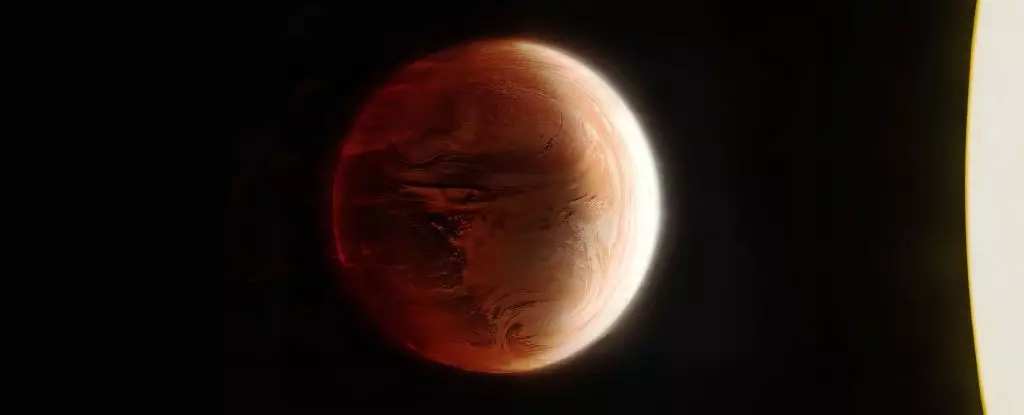In the realm of astrophysics, the discovery of exoplanets has long captured the imaginations of scientists and enthusiasts alike. Among these intriguing celestial bodies lies Tylos, officially known as WASP-121b, a remarkably extreme exoplanet located approximately 880 light-years away from Earth. It is not an exaggeration to describe Tylos as one of the most intense worlds uncovered in recent years. Scientists have recently made significant strides in understanding its complex atmospheric dynamics, revealing a three-dimensional structure that challenges our fundamental comprehension of planetary weather patterns. This discovery has uncovered atmospheric winds so fierce that they shatter previous records, illustrating a climate that diverges dramatically from anything experienced in our Solar System.
Tylos demonstrates several extraordinary features. With a surface temperature exceeding 2,360 Kelvin (approximately 2,087 degrees Celsius or 3,788 degrees Fahrenheit), this exoplanet is classified as a “hot Jupiter.” It is comparable in size to the gas giants of our own solar system, notably Jupiter, yet it resides in a perilously close orbit to its host star, Dilmun, a yellow-white F-type star. The conditions on Tylos are so extreme that not only are its atmospheric characteristics unique, but the planet itself is undergoing a process of evaporation due to the intense heat and gravitational influence exerted by its neighboring star.
The remarkable characteristics of Tylos’s atmosphere make it a prime candidate for detailed study. By observing how light filters through its thick and distorted atmosphere as it transits in front of its star, scientists can gather insights into the elemental makeup of its environment. Previous studies have identified metals such as iron and titanium within Tylos’s atmosphere, painting a picture of a world that feels almost otherworldly.
Utilizing the combined capabilities of the European Southern Observatory’s Very Large Telescope (VLT), researchers, including astrophysicist Julia Victoria Seidel, reconstructed Tylos’s atmospheric behavior and discovered extraordinary wind patterns. The results revealed the existence of a powerful jet stream that not only rotates around the planet’s equator but also transfers gases from the intensely hot hemisphere to the cooler side of the exoplanet. The dynamics at play in Tylos’s atmosphere are indicative of a climate that is not simply intense but defies our current understanding of what weather systems can look like across different celestial bodies.
Such velocities in wind dynamics are truly astonishing. The jet streams on Tylos can accelerate to impressive speeds, measured at 13.7 kilometers (8.5 miles) per second during the morning hours, increasing to a staggering 26.8 kilometers (16.7 miles) per second by evening. These measurements establish Tylos’s atmosphere as home to the fastest known wind patterns ever recorded. In terms of comparative weather phenomena, even the mightiest storms observed within our Solar System appear tame when contrasted with Tylos’s volatile atmospheric conditions.
One of the most fascinating aspects of Tylos is its constant exposure to the unrelenting heat of its host star, resulting in a temperature differential between the permanently sunlit side and the dark side of the planet. This duality creates extreme weather conditions, driving powerful winds that not only shape the atmosphere but also lead to the fascinating phenomenon of “metallic rain.” Here, meteorological conditions culminate in rain comprised of liquid sapphires and rubies, a visual spectacle that feels straight out of a science fiction novel.
The vertical circulation patterns observed in Tylos’s atmosphere also reveal an intriguing gradient of temperatures. A staggering 950 Kelvin temperature difference between morning and evening demonstrates just how dynamic and heated the jet stream can become during its flow. Observations have shown that winds carry clouds of iron at super-rotational speeds, outpacing the planet’s own rotation, while layers of sodium and hydrogen exist above, some of which are thought to be escaping into space due to the extreme conditions.
Discoveries pertaining to Tylos’s atmosphere signify a leap forward in our quest to understand exoplanets. As astrophysicist Bibiana Prinoth from Lund University eloquently states, the ability to study such intricate details of a planet located at an immense distance is indeed “mind-blowing.” The findings not only challenge our contemporary grasp of atmospheric dynamics but also broaden the scope of possibilities for other extreme worlds yet to be discovered.
Through the study of Tylos and similar exoplanets, researchers hope to unravel further mysteries of planetary weather and composition, ultimately contributing to our understanding of the diverse and complex universe beyond our solar neighborhood. Each new discovery poses fresh questions and highlights the stunning diversity of environments in the cosmos, revealing that the universe is full of surprises waiting to be uncovered.


Leave a Reply